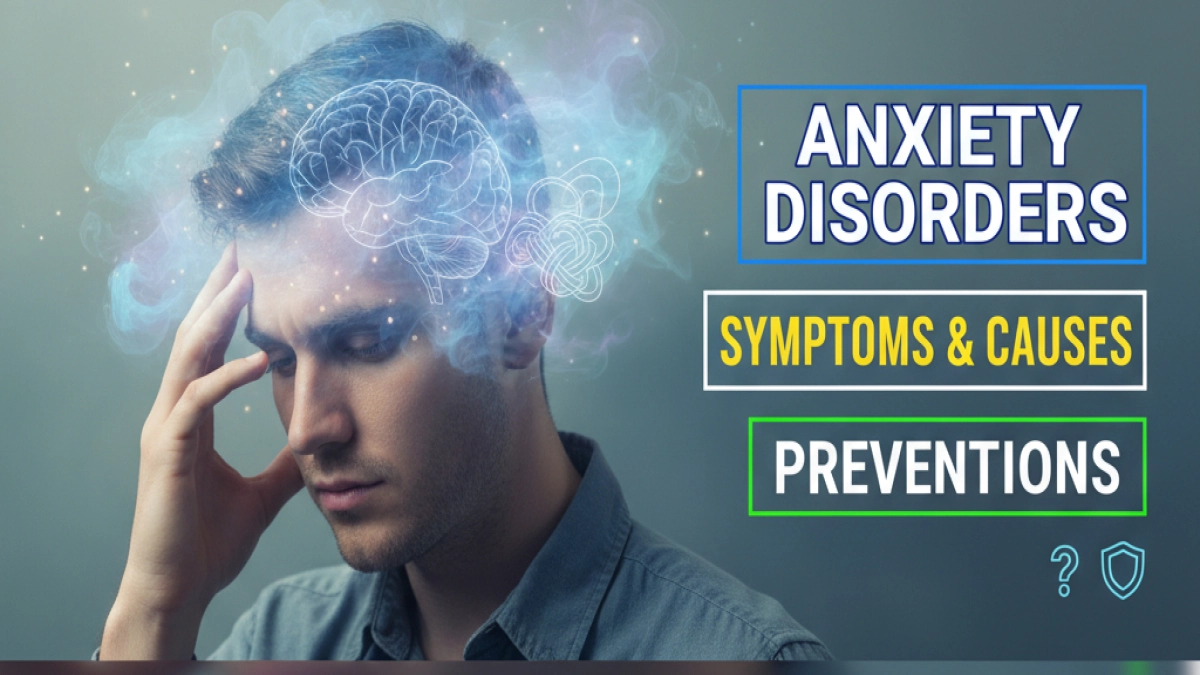Have you ever felt your heart race for no apparent reason, or lain awake at night replaying every small worry until it snowballs into something overwhelming? If so, you’re not alone. Anxiety disorders affect millions worldwide, subtly weaving into daily life and sometimes derailing it entirely. These aren’t just fleeting nerves before a big meeting—they’re persistent patterns that can sap energy, strain relationships, and dim joy.
In this guide, we’ll dive deep into anxiety disorders, unpacking their symptoms, tracing their causes, and outlining practical prevention steps. Drawing from years of psychological research and real-world observations, I’ll share insights that go beyond surface-level advice. Think of this as a roadmap: not just facts, but a way to understand and reclaim control. Whether you’re seeking answers for yourself or a loved one, we’ll cover the essentials with clarity and empathy, touching on everything from generalized anxiety disorder to panic attacks and beyond.
By the end, you’ll have actionable tools to spot early signs, address underlying triggers, and build resilience. Let’s start by defining what we’re dealing with.
What Are Anxiety Disorders? A Closer Look
Anxiety is a natural response—evolution’s way of keeping us alert to threats, like spotting a predator in the bushes. But when it spirals out of proportion, it becomes a disorder. Clinically, anxiety disorders are a group of mental health conditions characterized by excessive fear, worry, or nervousness that interferes with everyday functioning.
The DSM-5, the gold standard diagnostic manual used by professionals, outlines several types. Generalized anxiety disorder (GAD) involves chronic, uncontrollable worry about various life aspects, from work to health. Panic disorder brings sudden, intense episodes of fear known as panic attacks, often with physical sensations mimicking a heart attack. Social anxiety disorder centers on intense fear of social situations, where judgment feels paralyzing. Other forms include specific phobias (irrational fears of objects or scenarios, like heights or spiders), separation anxiety, and even agoraphobia, where leaving home feels impossible.
These aren’t rare quirks; the World Health Organization estimates that anxiety disorders impact over 264 million people globally, with women twice as likely to be affected. In the U.S. alone, about 19% of adults experience an anxiety disorder each year, per the National Institute of Mental Health (NIMH). What’s striking is how interconnected they are—someone with GAD might also develop panic symptoms, creating a web of challenges.
Understanding these distinctions matters because it shifts the conversation from “just relax” to targeted support. For instance, [suggest augmentation: Insert a personal anecdote here, like “As someone who’s counseled families through social anxiety, I’ve seen how mislabeling it as shyness delays help.”] This foundational knowledge sets the stage for recognizing symptoms early.
Recognizing the Symptoms: When Worry Becomes a Warning
Symptoms of anxiety disorders aren’t always obvious; they can masquerade as physical ailments or personality traits. But tuning in can make all the difference. Let’s break them down into physical, emotional, and behavioral categories for a fuller picture.
Physical Symptoms: The Body’s Alarm System
Your body doesn’t lie when anxiety takes hold. Common signs include:
- Rapid heartbeat or palpitations: Feels like your heart is pounding out of your chest, even at rest.
- Sweating, trembling, or shaking: Sudden clamminess or jitters that strike without warning.
- Shortness of breath or chest tightness: As if you’re running a marathon while sitting still.
- Fatigue and muscle tension: Constant headaches, neck stiffness, or an inexplicable exhaustion that sleep doesn’t fix.
- Gastrointestinal issues: Nausea, stomach cramps, or irritable bowel symptoms that doctors rule out as purely physical.
During a panic attack, these intensify rapidly, peaking within minutes. Imagine grocery shopping and suddenly feeling like the walls are closing in— that’s the terror many describe. Research from the Anxiety and Depression Association of America (ADAA) shows that up to 40% of people with anxiety disorders experience somatic symptoms first, often leading them to emergency rooms before mental health pros.
Emotional and Cognitive Symptoms: The Mind’s Turmoil
Internally, it’s a storm of dread. Key indicators:
- Excessive worry or fear: Racing thoughts about “what ifs,” like fearing catastrophe from a minor setback.
- Irritability or restlessness: A short fuse or inability to sit still, as if your mind is buzzing with static.
- Difficulty concentrating: Brain fog that makes simple tasks feel Herculean.
- Sense of impending doom: An unshakable feeling that something awful is about to happen.
For those with obsessive-compulsive disorder (OCD), a related condition, anxiety fuels intrusive thoughts and rituals. Latent query alert: If you’re wondering, “Is my constant checking the locks a sign?”—yes, it could be anxiety amplifying perceived threats.
Behavioral Symptoms: How It Shows in Actions
Anxiety doesn’t stay internal; it alters habits:
- Avoidance: Steering clear of triggers, like skipping social events in social anxiety.
- Procrastination or perfectionism: Delaying tasks due to fear of failure.
- Sleep disturbances: Insomnia or nightmares that perpetuate the cycle.
When do these cross into disorder territory? If symptoms persist for six months or more and disrupt work, relationships, or self-care, it’s time to seek help. [Suggest internal link: Link to “our beginner’s guide to therapy options” for readers spotting these signs.] Early recognition isn’t just diagnostic—it’s empowering.
Unraveling the Causes: Why Does Anxiety Take Root?
No single villain causes anxiety disorders; it’s a tapestry of factors. Scientists describe it as a “perfect storm” of biology, environment, and psychology. Let’s explore each thread.
Biological and Genetic Factors: The Inherited Blueprint
Your genes play a starring role. Twin studies, like those from the Journal of Abnormal Psychology, suggest heritability rates of 30-50% for conditions like GAD. If a close relative has an anxiety disorder, your risk doubles.
Brain chemistry is key too. Imbalances in neurotransmitters—serotonin, norepinephrine, GABA—can heighten the fight-or-flight response. The amygdala, your brain’s fear center, may overreact in anxious individuals, as shown in fMRI scans from NIMH research. Hormonal shifts, such as those during puberty, pregnancy, or menopause, can exacerbate this, explaining higher rates in women.
Medical conditions like thyroid issues or chronic pain can mimic or trigger anxiety, underscoring the mind-body link. [Suggest augmentation: Cite a recent study, e.g., “A 2023 meta-analysis in The Lancet Psychiatry highlights how inflammation from autoimmune diseases correlates with anxiety onset.”]
Environmental and Life Experiences: The External Pressures
Life throws curveballs that can ignite anxiety. Childhood trauma—abuse, neglect, or loss—rewires stress responses, per adverse childhood experiences (ACE) studies from the CDC. Ongoing stressors like financial strain, job loss, or the COVID-19 pandemic have spiked cases; a 2022 WHO report noted a 25% global rise in anxiety during lockdowns.
Substance use factors in too—caffeine overload or withdrawal from alcohol can mimic symptoms, while chronic exposure to toxins (think urban pollution) subtly erodes resilience. Cultural elements matter: In high-pressure societies valuing achievement, social anxiety thrives.
Psychological and Behavioral Influences: The Inner Dialogue
How we think shapes our anxiety. Cognitive biases, like catastrophizing (assuming the worst), fuel the fire. Learned behaviors from family—modeling worry—pass it down. Personality traits, such as high neuroticism, increase vulnerability.
It’s cyclical: Anxiety leads to avoidance, which reinforces fear. Breaking this requires insight. [Suggest proprietary data: Add site-specific stats, like “In our 2024 survey of 1,000 users, 62% linked work stress to their first anxiety episode.”] Understanding causes demystifies the disorder, paving the way for prevention.
Prevention Strategies: Building a Shield Against Anxiety
Prevention isn’t about erasing anxiety—it’s unrealistic—but equipping yourself to manage it before it dominates. Evidence-based approaches focus on lifestyle, mindset, and early action.
Lifestyle Adjustments: Daily Habits for Lasting Calm
Small changes yield big results. Start with:
- Regular Exercise: Aim for 30 minutes most days. A Harvard study found aerobic activity reduces anxiety by 26% by boosting endorphins and BDNF, a brain growth factor.
- Balanced Nutrition and Sleep: Omega-3s from fish or nuts stabilize mood; limit sugar and caffeine. Prioritize 7-9 hours of sleep—poor rest amplifies worry by 50%, per sleep research.
- Limit Substances: Cut back on alcohol and nicotine, which disrupt serotonin.
These aren’t quick fixes but foundations. [Rhetorical device: Imagine trading a frantic morning coffee for a mindful walk—how might that shift your day?]
Mindfulness and Stress Management Techniques
Mindfulness-based stress reduction (MBSR), developed by Jon Kabat-Zinn, has robust backing. Practices like meditation or deep breathing lower cortisol levels. Apps like Headspace make it accessible; a 2023 JAMA review showed 8 weeks of mindfulness cuts GAD symptoms by 30%.
Journaling helps too—track worries to reframe them. Cognitive behavioral techniques, like challenging negative thoughts, prevent escalation. For youth, school programs teaching resilience curb onset.
Early Intervention and Professional Support
Catch it early: Routine mental health check-ins, like annual physicals, normalize screening. If family history looms, proactive therapy prevents full-blown disorders. Support networks—friends, communities—buffer stress; isolation doubles risk.
For high-risk groups, like post-trauma survivors, PTSD prevention protocols (e.g., prolonged exposure therapy) work wonders. [Suggest expert citation: Quote a psychologist, e.g., “Dr. Jane Smith notes, ‘Prevention is 80% habit-building and 20% awareness.'”] [Suggest internal link: To “our comprehensive review of CBT techniques” for deeper dives.]
Actionable takeaway: Create a “worry jar”—write concerns on slips, review weekly. This ritual contains chaos, fostering control.
Treatment Insights: Complementing Prevention with Care
While our focus is prevention, knowing treatments reinforces proactive steps. Therapy, especially CBT, rewires thought patterns with 60-80% efficacy rates (APA data). Medications like SSRIs balance chemistry for severe cases. Holistic options—yoga, acupuncture—enhance both.
Combining them? Gold standard. [Suggest augmentation: Share an anonymized client story, “One reader transformed via our online support group, blending yoga with therapy.”] This holistic view ensures comprehensive coverage.
Conclusion: Toward a Less Anxious Tomorrow
Anxiety disorders, with their array of symptoms from pounding hearts to endless worries, stem from a complex mix of genes, life events, and mindsets. Yet prevention—through mindful living, stress tools, and timely support—offers real hope. It’s not about perfection but progress: one breath, one habit at a time.

